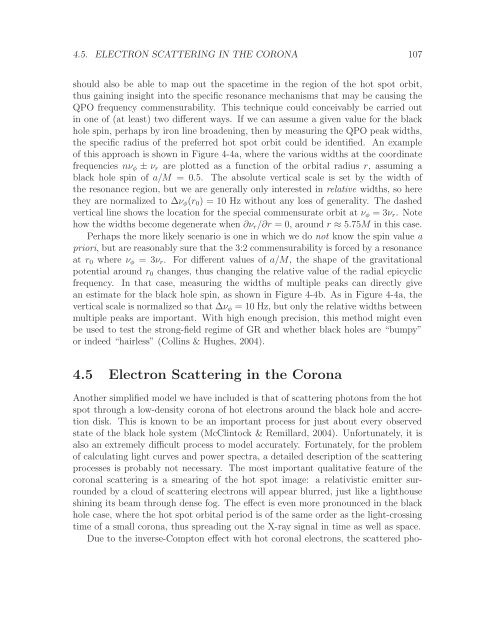Radiation Transport Around Kerr Black Holes Jeremy David ...
Radiation Transport Around Kerr Black Holes Jeremy David ...
Radiation Transport Around Kerr Black Holes Jeremy David ...
Create successful ePaper yourself
Turn your PDF publications into a flip-book with our unique Google optimized e-Paper software.
4.5. ELECTRON SCATTERING IN THE CORONA 107<br />
should also be able to map out the spacetime in the region of the hot spot orbit,<br />
thus gaining insight into the specific resonance mechanisms that may be causing the<br />
QPO frequency commensurability. This technique could conceivably be carried out<br />
in one of (at least) two different ways. If we can assume a given value for the black<br />
hole spin, perhaps by iron line broadening, then by measuring the QPO peak widths,<br />
the specific radius of the preferred hot spot orbit could be identified. An example<br />
of this approach is shown in Figure 4-4a, where the various widths at the coordinate<br />
frequencies nν φ ± ν r are plotted as a function of the orbital radius r, assuming a<br />
black hole spin of a/M = 0.5. The absolute vertical scale is set by the width of<br />
the resonance region, but we are generally only interested in relative widths, so here<br />
they are normalized to ∆ν φ (r 0 ) = 10 Hz without any loss of generality. The dashed<br />
vertical line shows the location for the special commensurate orbit at ν φ = 3ν r . Note<br />
how the widths become degenerate when ∂ν r /∂r = 0, around r ≈ 5.75M in this case.<br />
Perhaps the more likely scenario is one in which we do not know the spin value a<br />
priori, but are reasonably sure that the 3:2 commensurability is forced by a resonance<br />
at r 0 where ν φ = 3ν r . For different values of a/M, the shape of the gravitational<br />
potential around r 0 changes, thus changing the relative value of the radial epicyclic<br />
frequency. In that case, measuring the widths of multiple peaks can directly give<br />
an estimate for the black hole spin, as shown in Figure 4-4b. As in Figure 4-4a, the<br />
vertical scale is normalized so that ∆ν φ = 10 Hz, but only the relative widths between<br />
multiple peaks are important. With high enough precision, this method might even<br />
be used to test the strong-field regime of GR and whether black holes are “bumpy”<br />
or indeed “hairless” (Collins & Hughes, 2004).<br />
4.5 Electron Scattering in the Corona<br />
Another simplified model we have included is that of scattering photons from the hot<br />
spot through a low-density corona of hot electrons around the black hole and accretion<br />
disk. This is known to be an important process for just about every observed<br />
state of the black hole system (McClintock & Remillard, 2004). Unfortunately, it is<br />
also an extremely difficult process to model accurately. Fortunately, for the problem<br />
of calculating light curves and power spectra, a detailed description of the scattering<br />
processes is probably not necessary. The most important qualitative feature of the<br />
coronal scattering is a smearing of the hot spot image: a relativistic emitter surrounded<br />
by a cloud of scattering electrons will appear blurred, just like a lighthouse<br />
shining its beam through dense fog. The effect is even more pronounced in the black<br />
hole case, where the hot spot orbital period is of the same order as the light-crossing<br />
time of a small corona, thus spreading out the X-ray signal in time as well as space.<br />
Due to the inverse-Compton effect with hot coronal electrons, the scattered pho-
















